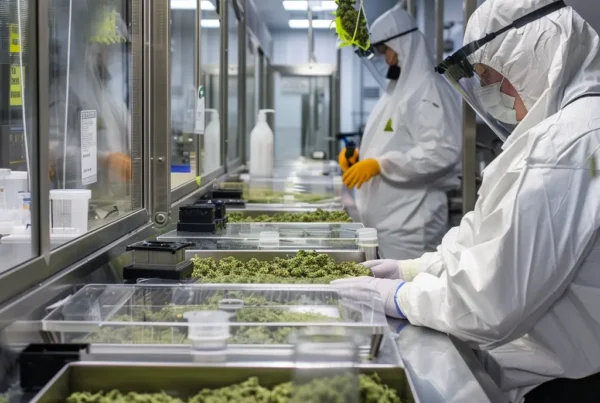Solvent-based extraction is a technique used to separate one part of a solid using a liquid solvent. This method is widely used in many industries, including the extraction of oils from seeds and the cannabis industry. It works by dissolving the desired component into the solvent, allowing it to be separated from the rest of the material. The process is known for its efficiency and ability to extract a wide range of compounds.
Key Takeaways
- Solvent-based extraction is a widely used method to separate components from solids using liquid solvents.
- Hexane and ethanol are among the most common solvents used in this extraction process.
- The cannabis industry frequently uses solvent-based extraction for its efficiency and ability to extract various compounds.
- While effective, solvent-based extraction raises safety and environmental concerns.
- Different techniques like liquid-liquid extraction and solid-liquid extraction are used based on the material and desired outcome.
Overview of Solvent-Based Extraction
Definition and Principles
Solvent-based extraction is a method used to separate one component from a solid using a liquid solvent. This technique is widely used in various industries due to its efficiency and ability to extract a wide range of compounds. The process involves dissolving the desired substance in a solvent, which is then separated from the remaining material.
Historical Context
The use of solvents for extraction dates back to ancient times when people used natural solvents like water and alcohol to extract essential oils and other valuable compounds from plants. Over the years, the methods have evolved, and now, more advanced solvents and techniques are used to achieve higher purity and yield.
Current Applications
Today, solvent-based extraction is used in many industries, including food and beverage, pharmaceuticals, and cosmetics. It is particularly popular in the cannabis industry, where it is used to extract cannabinoids and terpenes from the plant material. The method’s versatility and effectiveness make it a preferred choice for many applications.
Solvent-based extraction remains a cornerstone in various industries due to its ability to efficiently separate desired compounds from raw materials.
Common Solvents Used in Extraction
Hexane
Hexane is a popular choice for extraction due to its high efficiency in separating oils and other compounds. It is often used in the food industry to extract vegetable oils from seeds and other plant materials. However, its use is sometimes limited due to safety concerns, as it is highly flammable and can be toxic if not handled properly.
Ethanol
Ethanol is widely used in various extraction processes, especially in the cannabis industry. It is favored for its ability to extract a wide range of compounds, including cannabinoids and terpenes. Ethanol is considered a "green" solvent because it is less toxic and more environmentally friendly compared to other solvents. Its versatility and safety make it a preferred choice for many applications.
Other Emerging Solvents
While traditional solvents like hexane and ethanol are commonly used, there is growing interest in emerging solvents that offer better safety and environmental profiles. These include deep eutectic solvents and supercritical fluids like carbon dioxide (CO2). These new solvents are being researched for their potential to provide efficient extraction while minimizing health and environmental risks.
Although different extraction methods have been applied in the literature, the use of green approaches using ethanol and deep eutectic solvents has increased, highlighting the shift towards safer and more sustainable practices.
Solvent-Based Extraction in the Cannabis Industry
Solvent-based extraction methods have become very popular in the cannabis industry because they are efficient and can extract many different compounds. Let’s look at some of the commonly used solvent-based extraction methods.
Hydrocarbon Extraction
Hydrocarbon extraction uses solvents like butane or propane to pull out the desired compounds from cannabis. This method is known for producing high-quality extracts quickly. However, it requires careful handling due to the flammable nature of the solvents.
Ethanol Extraction
Ethanol extraction is another widely used method. Ethanol is a food-grade solvent, making it a safer option for extracting compounds from cannabis. This method is also efficient and can be used for both small and large-scale operations.
CO2 Extraction
CO2 extraction uses carbon dioxide in its supercritical state to extract compounds from cannabis. This method is highly efficient and produces very pure extracts. It is also considered safer and more environmentally friendly compared to hydrocarbon extraction.
Solvent-based methods are best for producing large-scale, industrial yields more quickly. Solventless methods are more cost-effective on a smaller scale and have different applications.
Advantages and Disadvantages of Solvent-Based Extraction
Efficiency and Yield
Solvent-based extraction methods are known for their high efficiency and yield. These methods can extract a wide range of compounds, making them versatile for various applications. One key advantage is the ability to achieve high purity levels in the extracted product. However, the efficiency can vary depending on the solvent used and the specific extraction process.
Safety Concerns
The use of organic solvents in extraction processes poses significant safety risks. These solvents are often flammable and can be hazardous to the health of operators. Proper handling and storage are crucial to minimize these risks. Additionally, there are concerns about residual solvents in the final product, which can be harmful if ingested or inhaled.
Environmental Impact
Solvent-based extraction methods can have a considerable environmental impact. The use of organic solvents contributes to pollution and can be harmful to ecosystems. Efforts are being made to develop greener alternatives and improve the sustainability of these processes. However, the environmental footprint remains a significant drawback.
The drawbacks of solvent-based extraction have led to increased research into alternative methods that are safer and more environmentally friendly.
Summary Table
| Aspect | Advantages | Disadvantages |
|---|---|---|
| Efficiency and Yield | High efficiency and purity | Varies with solvent and process |
| Safety Concerns | – | Flammable, hazardous to health |
| Environmental Impact | – | Contributes to pollution, harmful to ecosystems |
Solvent Extraction Techniques
Liquid-Liquid Extraction
Liquid-liquid extraction, also known as partitioning, involves separating substances based on their solubility in two different immiscible liquids. This method is highly effective for isolating compounds that are sensitive to heat or have high boiling points. It is widely used in various industries due to its simplicity and cost-effectiveness.
Solid-Liquid Extraction
Solid-liquid extraction is the process of removing a component from a solid material using a liquid solvent. This technique is commonly used in the food industry to extract oils from seeds and nuts. The choice of solvent is crucial, as it affects the efficiency and quality of the extraction.
Accelerated Solvent Extraction
Accelerated solvent extraction (ASE) is a technique that uses high pressure and temperature to speed up the extraction process. ASE is particularly useful for extracting compounds from complex matrices, such as plant materials. It offers the advantage of reduced extraction time and solvent usage, making it an environmentally friendly option.
Understanding these techniques is essential for optimizing extraction processes in various industries, including food, pharmaceuticals, and cosmetics.
Applications in Different Industries
Food and Beverage
Solvent-based extraction is widely used in the food and beverage industry to obtain flavors, colors, and essential oils from natural sources. This method ensures high purity and quality of the extracted compounds. For example, vanilla extract and essential oils from citrus fruits are commonly produced using solvent extraction.
Pharmaceuticals
In the pharmaceutical industry, solvent-based extraction is crucial for isolating active ingredients from plants and other natural sources. This technique helps in creating medications that are both effective and safe for patients. High-cbd cannabis seeds are often processed using solvent extraction to produce CBD oil, which is used for various therapeutic purposes.
Cosmetics
The cosmetics industry relies on solvent-based extraction to obtain natural ingredients like essential oils, fragrances, and antioxidants. These extracts are used in a wide range of products, from skincare creams to perfumes. The method ensures that the final products are both effective and safe for consumer use.
Solvent-based extraction plays a vital role in multiple industries, ensuring the purity and quality of the final products.
Conclusion
Solvent-based extraction is a widely used method for separating components from various materials. This technique is especially popular in industries like oil extraction and cannabis processing due to its efficiency and cost-effectiveness. By using different solvents, we can target specific compounds and achieve high purity levels. While hexane is commonly used, other solvents are being explored to improve safety and environmental impact. Overall, solvent-based extraction remains a crucial tool in both industrial and laboratory settings, offering a reliable way to obtain desired substances from complex mixtures.
Frequently Asked Questions
What is solvent-based extraction?
Solvent-based extraction is a method where a liquid solvent is used to remove one component from a solid. It’s commonly used to extract oil from seeds and other plant materials.
What are the common solvents used in extraction?
Hexane and ethanol are the most commonly used solvents. However, new solvents are also being explored for their effectiveness.
How is solvent-based extraction used in the cannabis industry?
In the cannabis industry, solvent-based extraction methods like hydrocarbon extraction, ethanol extraction, and CO2 extraction are popular for obtaining various compounds from the plant.
What are the advantages of solvent-based extraction?
This method is efficient and can yield a high amount of extracted material. It’s also relatively simple and cost-effective.
What are the disadvantages of solvent-based extraction?
Safety concerns and environmental impact are the main drawbacks. The use of chemicals can be hazardous, and improper disposal can harm the environment.
What industries use solvent-based extraction?
Solvent-based extraction is used in many industries, including food and beverage, pharmaceuticals, and cosmetics, to obtain various compounds from raw materials.






